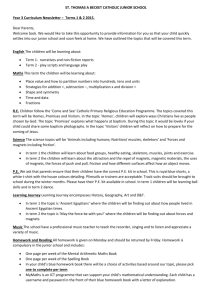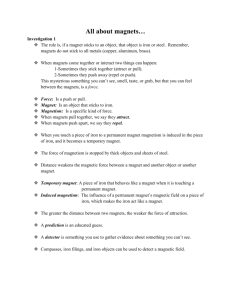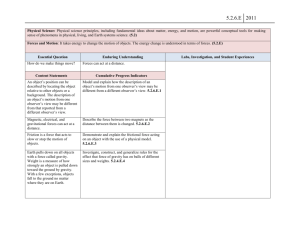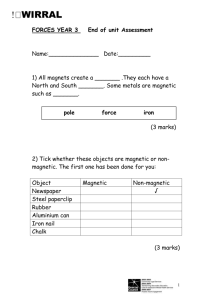2-5.3 - S2TEM Centers SC
advertisement
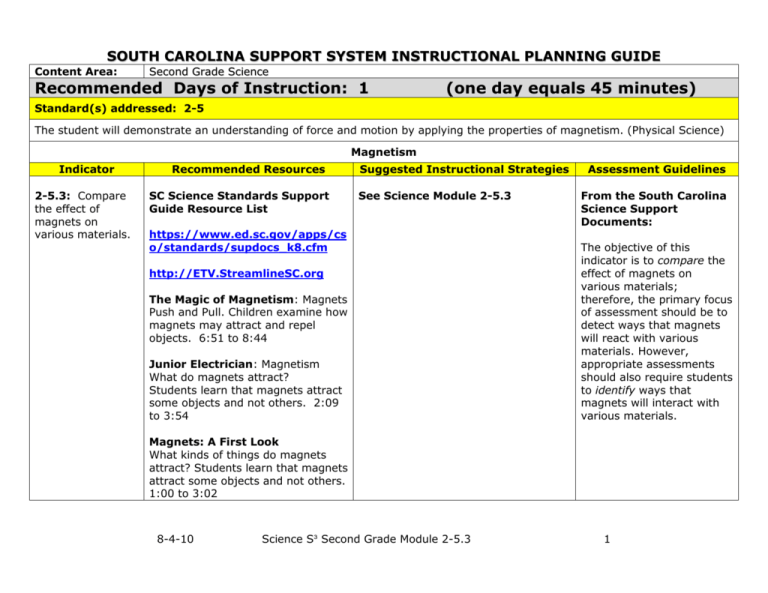
SOUTH CAROLINA SUPPORT SYSTEM INSTRUCTIONAL PLANNING GUIDE Content Area: Second Grade Science Recommended Days of Instruction: 1 (one day equals 45 minutes) Standard(s) addressed: 2-5 The student will demonstrate an understanding of force and motion by applying the properties of magnetism. (Physical Science) Magnetism Indicator 2-5.3: Compare the effect of magnets on various materials. Recommended Resources SC Science Standards Support Guide Resource List Suggested Instructional Strategies See Science Module 2-5.3 https://www.ed.sc.gov/apps/cs o/standards/supdocs_k8.cfm http://ETV.StreamlineSC.org The Magic of Magnetism: Magnets Push and Pull. Children examine how magnets may attract and repel objects. 6:51 to 8:44 Junior Electrician: Magnetism What do magnets attract? Students learn that magnets attract some objects and not others. 2:09 to 3:54 Assessment Guidelines From the South Carolina Science Support Documents: The objective of this indicator is to compare the effect of magnets on various materials; therefore, the primary focus of assessment should be to detect ways that magnets will react with various materials. However, appropriate assessments should also require students to identify ways that magnets will interact with various materials. Magnets: A First Look What kinds of things do magnets attract? Students learn that magnets attract some objects and not others. 1:00 to 3:02 8-4-10 Science S³ Second Grade Module 2-5.3 1 Second Grade Science Module 2-5.3 Magnetism Lesson A Standard 2-5: The student will demonstrate an understanding of force and motion by applying the properties of magnetism. (Physical Science) Indicator 2-5.3: Compare the effect of magnets on various materials. Other indicators addressed: 2-1.1: Carry out simple scientific investigations to answer questions about familiar objects or events. 2-1.2: Represent and communicate simple data and explanations through drawings, tables, pictographs, bar graphs, and oral and written language. 2-1.4: Infer explanations regarding scientific observations and experiences. 2-1.5: Use appropriate safety procedures when conducting investigations. 8-4-10 Science S³ Second Grade Module 2-5.3 2 From the South Carolina Science Support Documents: Indicator 2-5.3: Compare the effect of magnets on various materials. Taxonomy level: Understand Conceptual Knowledge (2.6-B) Previous/Future knowledge: In kindergarten (K-5.1), students classified object’s observable properties including magnetic attraction. This concept will be further developed in 4th grade (4-5.9) when they summarize the properties of magnets and electromagnets (including polarity, attraction/repulsion, and strength). It is essential for students to know the effect of magnets on various materials. A magnet is solid material that attracts iron or products that contain iron like steel. If a material does not have iron in its composition, the magnet will not attract it. NOTE TO TEACHER: A possible misconception can be formed if students do not realize some objects that look like metal do not contain iron, therefore they do not have magnetic properties, and they will not be attracted to a magnet. SAFETY NOTE TO TEACHER: The effect of magnets on various materials is a very important classroom safety issue. Students need to know that they should not use magnets around computers, computer disks, TVs, VCRs, tape recorders, videotapes, or cassette tapes. Continual use of magnets around these materials will cause them to not work properly or their contents will be erased. It is not essential for students to know that cobalt and nickel also have magnetic properties. Assessment Guidelines: The objective of this indicator is to compare the effect of magnets on various materials; therefore, the primary focus of assessment should be to detect ways that magnets will react with various materials. However, appropriate assessments should also require students to identify ways that magnets will interact with various materials. 8-4-10 Science S³ Second Grade Module 2-5.3 3 Teaching Indicator 2-5.3: Lesson A – “Magnetic Attraction” Instructional Considerations: Magnets are tools which pick up (attract) some things but do not pick up other things. Things which magnets attract are called magnetic objects. Things that magnets do not attract are called non-magnetic objects. In this lesson, students test various objects for the observable property of magnetism. Misconceptions: A possible misconception can be formed if students do not realize some objects that look like metal do not contain iron, therefore they do not have magnetic properties, and they will not be attracted to a magnet. Safety Note: The effect of magnets on various materials is a very important classroom safety issue. Students need to know that they should not use magnets around computers, computer disks, TVs, VCRs, tape recorders, videotapes, or cassette tapes. Continual use of magnets around these materials will cause them to not work properly or their contents will be erased. Lesson time: 1 day (one day equals 45 minutes) Materials Needed: Bar or ring magnets (one for each child) Red paper (one sheet per pair of students) Green paper (one sheet per pair of students) Bag of test objects : Re-sealable plastic bag containing a jumbo paper clip, a rock, a piece of aluminum foil, a piece of cloth, a washer, a piece of straw, a paper fastener, a piece of pipe cleaner, a leaf, a nail, a screw, a piece of wire, a piece of wood and a button (one bag per pair of students) Student notebooks Pencils Chart paper Markers Focus Question (s): What objects are attracted to magnets? What objects are not attracted to magnets? Engage: 1. The teacher uses a magnet, a regular paper clip and a piece of paper in a demonstration to begin the lesson. 2. Show the children the magnet and paper clip and ask if the paper clip will stick to the magnet. 8-4-10 Science S³ Second Grade Module 2-5.3 4 3. Show them that it will and remind them of the word “attract” introduce in module 2-5.2. 4. Now repeat the above steps with the magnet and paper. 5. Explain that the paper is not attracted to the magnet. 6. Explain that in today’s lesson they will test to find out which objects are attracted to a magnet and which are not. Explore: 1. Divide the class into pairs and give each pair two bar or ring magnets, a sheet of green construction paper, a sheet of red construction paper and a re-sealable bag containing the test objects. 2. Each partner in the pair should have a magnet. 3. Ask them to take the objects out of the bag, one at a time, and have each partner test it with his/her magnet. 4. If the object sticks to the magnets, have them place it on the green paper. If it does not stick to the magnets, have them place it on the red paper. 5. Continue testing each object in the bag (including the bag itself) placing each one on the correct sheet of paper. 6. In the student notebooks, ask students to draw two columns on a page. 7. At the top of one column write the word “yes”. Over the other column write the word “no”. (You may need to demonstrate this on the board.) 8. Ask the students to draw or write the names of all the objects that were attracted to the magnet (green sheet of paper) under the “yes” column. 9. Now ask them to draw or write the names of all of the objects that were not attracted to the magnet (red sheet of paper) under the “no” column. Explain: 1. As you assemble the class into a whole group, ask each pair of students to keep their red sheet objects and green sheet objects together on the paper so that they can be used during the discussion. Ask questions such as: Did any of the objects surprise you? Which ones? Why? How are the objects on the green paper similar? What do you notice about the objects on the red paper? Are there some objects on the red paper that you would have thought would be on the green paper? Which ones? Why did you think that? 2. Explain to the children that the objects on the green paper are “magnetic” and the objects on the red paper are “non-magnetic”. 3. Explain that the magnetic contain metals called “iron” or “steel” and that objects with these metals are attracted to magnets. 4. Explain that some of the objects on the red sheet are made of metal but it is a different metal than iron or steel so they are not attracted to the magnets. 5. Record the students’ new learning on the KWL chart begun in module 2.5-1 or on new chart paper to be posted in the room for future reference and review. 8-4-10 Science S³ Second Grade Module 2-5.3 5 Extend: 1. Provide the children with a ring or bar magnet and ask them to test objects around the room for the property of magnetism. 2. Explain to them that they are to find five magnetic objects and five nonmagnetic objects. 3. Remind them of the safety note to not test any of the electronic equipment in the room with magnets. 4. Have the students return to their seats and record their observations through drawing/writing. 5. Discuss the students’ observations as a class, being sure to use the correct terminology of magnetic, non-magnetic, iron, steel and attract. 8-4-10 Science S³ Second Grade Module 2-5.3 6

